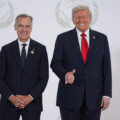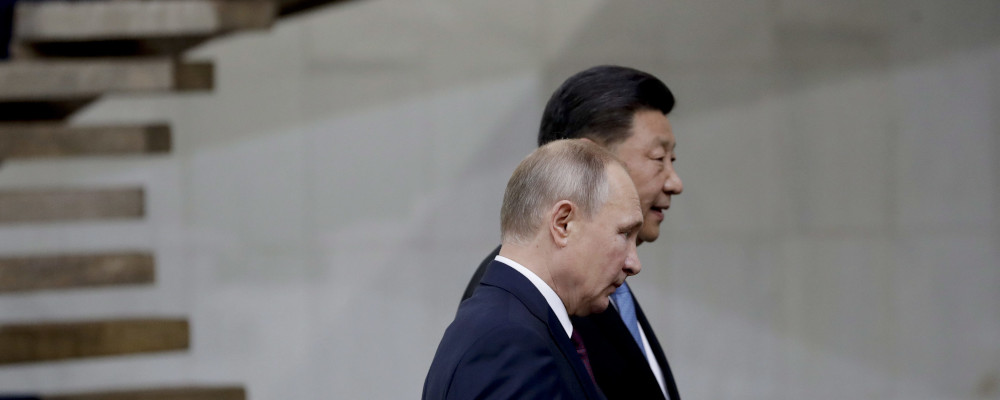Democracies around the world face an important new challenge with an authoritarian axis being formed around Russia and China.
The despotic regimes of Putin and Xi are increasingly acting in concert with each other — an alignment that can be seen in a range of policies, including on defence cooperation, subverting international norms and institutions, and on the question of cyber-governance and information security.
Given their hostility to universal human rights and democracy, their “Animal Farm” understanding of sovereignty — in which some countries are more sovereign than others and only major powers are truly sovereign — their desire to make the world safe for autocracy, and their increasingly revanchist policies, the Sino-Russian alignment poses a serious challenge to the rules-based international order and its defenders.
As I outlined in a recent paper for the Macdonald-Laurier Institute, Russia and China are strange bedfellows driven to one another by their shared neo-authoritarian ideology, obsession with regime security, and conviction that the West is in terminal decline.
Ideologically, both countries are led by strong men who believe in their own indispensability for promoting economic growth, protecting the regime, and advancing their national interests abroad. Here the personal fortunes of the leader are assumed to be one and the same with the national interest and thus any threat to Putin’s or Xi’s rule is perceived to be an existential threat to Russia or China.
Such regimes cannot tolerate dissent, at home or abroad. They are characterized by suppression of free speech, tight control of traditional and social media, repression against political and religious dissident groups, and especially in the case of PRC, a vast surveillance infrastructure that reaches every aspect of political and social life.
Russia and China share a common interest in undermining the status quo.
This shared neo-authoritarian ideology enables Putin and Xi to frame their common opposition to the rules-based international order and surmount the lingering suspicions between both countries dating back to the Cold War.
Russia and China share a common interest in undermining the status quo. They perceive the international order — underpinned by common rules, liberal values, and a near-hegemonic democratic superpower — as an inherent and existential threat to their respective ruling regime. The imperative of regime survival is crucial to understand the Sino-Russian alignment at the international level and makes the strategic partnership between Russia and China an enduring one.
The CCP — the clear dominant force in this emerging partnership — explicitly identifies values and norms such as liberal democracy, freedom of press, freedom of expression, and human rights as threats to its rule in its own internal documents. In the eyes of the CCP, the existence of a thriving democracy right across the strait in Taiwan increases the urgency of undermining the rules-based international order led by the world’s democracies.
Both China and Russia believe they need to speed up a shift in global power away from the West and restructure the international order to their liking. Engaging in subversion against the West is a crucial component of this strategy and a natural driver for their alignment.
The outgrowth of this strategy is a range of destabilizing activities, such as economic coercion, diplomatic belligerence, military threats, maritime bullying, territorial incursions, and more. Such heavy-handed tactics have defined Russia and China under their current leadership. Emboldened by one another, and in the absence of a coherent response from the West, the Sino-Russian partnership operates with greater abandon, coherence and nerve.
How should the West respond to this challenge? The worst choice is almost certainly what appears to be the present strategy: wait and see, hoping that the partnership will dissolve or that some dispute forces Xi and Putin to look in opposite directions. Yet wishful thinking is no substitute for strategy.
Another option is to pursue a wedge strategy. There are existing and potential differences between two countries on a number of fronts — from the growing power asymmetry that clearly favours China to their rivalry when it comes to both influence in Central Asia and arms sales. It is possible that Russia might, in this context, be dissuaded from supporting a partnership with China that has left Russia as the junior partner. After all, no one wants to be the horse, and everyone wants to be the rider.
Defence-spending laggards like Canada need to start paying their fair share into collective defence.
However, it is important not to overstate these otherwise modest disagreements. And the tensions that come with a power imbalance pale in comparison to the drivers of the relationship between Russia and China. Both countries realize they each have more to gain in their continued cooperation. Besides, Russia would need to be at least somewhat accommodating to the West for this wedge strategy to succeed. And Moscow has proven time and time again to be precisely the opposite of anything the West might describe as “cooperative.”
Instead of attempting to play the two authoritarian regimes off one another, we should bank on a much more solid strategy of solidarity and deterrence. Only by being able to confront, stand up to, and ultimately push back against the dual threats of a Sino-Russian alignment can we dissuade such a power bloc from undermining the rules-based international order. We must be resolute and firm in communicating that the goals of these authoritarian partners cannot be accomplished even through their cooperation, and thus encourage both countries to engage in rule-abiding behaviour.
To do this requires more than idle words. We must instead develop a coordinated, multilayered and multilateral strategy. On one hand, the U.S .needs to take the lead in pushing back against Russia and China, as only the U.S. has the assets and indeed power to do so successfully. On the other hand, the West and other democratic partners should coordinate in the dual-containment of this authoritarian axis. That will help capitalize on the individual strengths of each democratic partner and amplify each other’s capabilities across domains and geographies.
To coordinate these efforts requires an institutional structure — an “alliance of democracies” to coordinate efforts among our partners and defend international institutions will be imperative for this effort to succeed. This also means that our values such as democracy, the rule of law, and human rights should be reaffirmed and defended without apology, as these values ultimately underpin our shared interests. And ultimately, we must retain a defence advantage over these authoritarian powers. This means defence-spending laggards like Canada need to start paying their fair share into collective defence.
As we emerge into a post-pandemic world, Canada and its allies and partners need to have a clear-eyed view of the challenge posed by this authoritarian axis. The future of the rules-based international order, liberal democracy, and individual rights and freedoms depends on how well we confront this task. It’s time that democracies join together to fight back.
Recommended for You

Poilievre will survive as CPC leader, and Canada will stay golden in men’s hockey: The Hub predicts 2026

Supply management will be sacrificed to appease Trump, and the Netflix takeover is bad for Hollywood: The Hub predicts 2026

Canada will attempt to join the EU and Justin Trudeau becomes a Katy Perry lyric: The Hub predicts 2026

Why Danielle Smith is the newsmaker of the year




Comments (0)